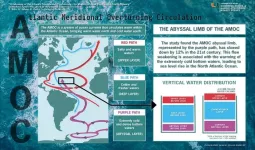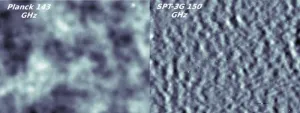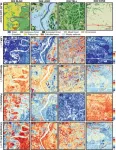(Press-News.org) In a discovery that could hasten treatment for patients with multiple sclerosis (MS), UC San Francisco scientists have discovered a harbinger in the blood of some people who later went on to develop the disease.
In about 1 in 10 cases of MS, the body begins producing a distinctive set of antibodies against its own proteins years before symptoms emerge. These autoantibodies appear to bind to both human cells and common pathogens, possibly explaining the immune attacks on the brain and spinal cord that are the hallmark of MS.
The findings were published in Nature Medicine on April 19.
MS can lead to a devastating loss of motor control, although new treatments can slow the progress of the disease and, for example, preserve a patient’s ability to walk. The scientists hope the autoantibodies they have discovered will one day be detected with a simple blood test, giving patients a head start on receiving treatment.
“Over the last few decades, there's been a move in the field to treat MS earlier and more aggressively with newer, more potent therapies,” said UCSF neurologist Michael Wilson, MD, a senior author of the paper. “A diagnostic result like this makes such early intervention more likely, giving patients hope for a better life.”
Linking infections with autoimmune disease
Autoimmune diseases like MS are believed to result, in part, from rare immune reactions to common infections.
In 2014, Wilson joined forces with Joe DeRisi, PhD, president of the Chan Zuckerberg Biohub SF and a senior author of the paper, to develop better tools for unmasking the culprits behind autoimmune disease. They took a technique in which viruses are engineered to display bits of proteins like flags on their surface, called phage display immunoprecipitation sequencing (PhIP-Seq), and further optimized it to screen human blood for autoantibodies.
PhIP-Seq detects autoantibodies against more than 10,000 human proteins, enough to investigate nearly any autoimmune disease. In 2019, they successfully used it to discover a rare autoimmune disease that seemed to arise from testicular cancer.
MS affects more than 900,000 people in the US. Its early symptoms, like dizziness, spasms, and fatigue, can resemble other conditions, and diagnosis requires careful analysis of brain MRI scans.
The phage display system, the scientists reasoned, could reveal the autoantibodies behind the immune attacks of MS and create new opportunities to understand and treat the disease.
The project was spearheaded by first co-authors Colin Zamecnik, PhD, a postdoctoral researcher in DeRisi’s and Wilson’s labs; and Gavin Sowa, MD, MS, former UCSF medical student and now internal medicine resident at Northwestern University.
They partnered with Mitch Wallin, MD, MPH, from the University of Maryland and a senior author of the paper, to search for autoantibodies in the blood of people with MS. These samples were obtained from the U.S. Department of Defense Serum Repository, which stores blood taken from armed service members when they apply to join the military.
The group analyzed blood from 250 MS patients collected after their diagnosis, plus samples taken five or more years earlier when they joined the military. The researchers also looked at comparable blood samples from 250 healthy veterans.
Between the large number of subjects and the before-and-after timing of the samples, it was “a phenomenal cohort of individuals to look at to see how this kind of autoimmunity develops over the course of clinical onset of this disease,” said Zamecnik.
A consistent signature of MS
Using a mere one-thousandth of a milliliter of blood from each time point, the scientists thought they would see a jump in autoantibodies as the first symptoms of MS appeared.
Instead, they found that 10% of the MS patients had a striking abundance of autoantibodies years before their diagnosis.
The dozen or so autoantibodies all stuck to a chemical pattern that resembled one found in common viruses, including Epstein-Barr Virus (EBV), which infects more than 85% of all people, yet has been flagged in previous studies as a contributing cause for MS.
Years before diagnosis, this subset of MS patients had other signs of an immune war in the brain. Ahmed Abdelhak, MD, co-author of the paper and a postdoctoral researcher in the UCSF laboratory of Ari Green, MD, found that patients with these autoantibodies had elevated levels of neurofilament light (Nfl), a protein that gets released as neurons break down.
Perhaps, the researchers speculated, the immune system was mistaking friendly human proteins for some viral foe, leading to a lifetime of MS.
“When we analyze healthy people using our technology, everybody looks unique, with their own fingerprint of immunological experience, like a snowflake,” DeRisi said. “It’s when the immunological signature of a person looks like someone else, and they stop looking like snowflakes that we begin to suspect something is wrong, and that’s what we found in these MS patients.”
A test to speed patients toward the right therapies
To confirm their findings, the team analyzed blood samples from patients in the UCSF ORIGINS study. These patients all had neurological symptoms and many, but not all, went on to be diagnosed with MS.
Once again, 10% of the patients in the ORIGINS study who were diagnosed with MS had the same autoantibody pattern. The pattern was 100% predictive of an MS diagnosis. Across both the Department of Defense group and the ORIGINS group, every patient with this autoantibody pattern had MS.
“Diagnosis is not always straightforward for MS, because we haven’t had disease specific biomarkers,” Wilson said. “We’re excited to have anything that can give more diagnostic certainty earlier on, to have a concrete discussion about whether to start treatment for each patient.”
Many questions remain about MS, ranging from what’s instigating the immune response in some MS patients to how the disease develops in the other 90% of patients. But the researchers believe they now have a definitive sign that MS is brewing.
“Imagine if we could diagnose MS before some patients reach the clinic,” said Stephen Hauser, MD, director of the UCSF Weill Institute for Neurosciences and a senior author of the paper. “It enhances our chances of moving from suppression to cure.”
For funding and disclosures, see the paper.
Other UCSF authors are Ravi Dandekar, Rebecca D. Bair, Kristen J. Wade, Christopher M. Bartley, Asritha Tubati, Refujia Gomez, Camille Fouassier, Chloe Gerungan, Jessica Alexander, Anne E. Wapniarski, Rita P. Loudermilk, Erica L. Eggers, Kelsey C. Zorn, Kirtana Ananth, Nora Jabassini, Sabrina A. Mann, Nicholas R. Ragan, Adam Santaniello, Roland G. Henry, Sergio E. Baranzini, Scott S. Zamvil, Riley M. Bove, Chu-Yueh Guo, Jeffrey M. Gelfand, Richard Cuneo, H.-Christian von Büdingen, Jorge R. Oksenberg, Bruce AC Cree, Jill A. Hollenbach, and Ari J. Green. For all authors, see the paper.
About UCSF: The University of California, San Francisco (UCSF) is exclusively focused on the health sciences and is dedicated to promoting health worldwide through advanced biomedical research, graduate-level education in the life sciences and health professions, and excellence in patient care. UCSF Health, which serves as UCSF's primary academic medical center, includes top-ranked specialty hospitals and other clinical programs, and has affiliations throughout the Bay Area. UCSF School of Medicine also has a regional campus in Fresno. Learn more at https://ucsf.edu, or see our Fact Sheet.
###
Follow UCSF
ucsf.edu | Facebook.com/ucsf | YouTube.com/ucsf
END
Signs of multiple sclerosis show up in blood years before symptoms
UCSF scientists clear a potential path toward earlier treatment for a disease that affects nearly 1,000,000 people in the United States
2024-04-19
ELSE PRESS RELEASES FROM THIS DATE:
Ghost particle on the scales
2024-04-19
In the 1930s, it turned out that neither the energy nor the momentum balance is correct in the radioactive beta decay of an atomic nucleus. This led to the postulate of "ghost particles" that "secretly" carry away energy and momentum. In 1956, experimental proof of such neutrinos was finally obtained. The challenge: neutrinos only interact with other particles of matter via the weak interaction that is also underlying the beta decay of an atomic nucleus. For this reason, hundreds of trillions of neutrinos from the cosmos, especially the sun, can pass through our bodies every second without causing any damage. Extremely ...
Light show in living cells
2024-04-19
Observing proteins precisely within cells is extremely important for many branches of research but has been a significant technical challenge - especially in living cells, as the required fluorescent labelling had to be individually attached to each protein. The research group led by Stefan Kubicek at CeMM has now overcome this hurdle: With a method called "vpCells," it is possible to label many proteins simultaneously, using five different fluorescent colours. This automated high-throughput approach, aided by AI-assisted image recognition, opens up entirely new applications in various disciplines, from fundamental cell biology to drug discovery. The study ...
Climate change will increase value of residential rooftop solar panels across US, study shows
2024-04-19
Graphic
Climate change will increase the future value of residential rooftop solar panels across the United States by up to 19% by the end of the century, according to a new University of Michigan-led study.
The study defines the value of solar, or VOS, as household-level financial benefits from electricity bill savings plus revenues from selling excess electricity to the grid—minus the initial installation costs.
For many U.S. households, increased earnings from residential rooftop ...
Could the liver hold the key to better cancer treatments?
2024-04-19
PHILADELPHIA – Liver inflammation, a common side-effect of cancers elsewhere in the body, has long been associated with worse cancer outcomes and more recently associated with poor response to immunotherapy. Now, a team led by researchers from the Abramson Cancer Center and Perelman School of Medicine at the University of Pennsylvania has found a big reason why.
In their study, published today in Nature Immunology, the researchers discovered that cancer-induced liver inflammation causes liver cells to secrete proteins called serum amyloid A (SAA) proteins, which circulate through the body and hinder the ability of T cells—major anticancer weapons of the immune system—to ...
Warming of Antarctic deep-sea waters contribute to sea level rise in North Atlantic, study finds
2024-04-19
Analysis of mooring observations and hydrographic data suggest the Atlantic Meridional Overturning Circulation deep water limb in the North Atlantic has weakened. Two decades of continual observations provide a greater understanding of the Earth’s climate regulating system.
A new study published in the journal Nature Geoscience led by scientists at University of Miami Rosenstiel School of Marine, Atmospheric, and Earth Science, and the National Oceanic and Atmospheric Administration’s Atlantic ...
Study opens new avenue for immunotherapy drug development
2024-04-19
HOUSTON ― In a new study published today in Nature Biomedical Engineering, researchers at The University of Texas MD Anderson Cancer Center have designed a new method for developing immunotherapy drugs using engineered peptides to elicit a natural immune response inside the body.
In preclinical models of locally advanced and metastatic breast cancer, this method improved tumor control and prolonged survival, both as a monotherapy and in combination with immune checkpoint inhibitors.
“Amino acids are the building blocks of life and, when a few of them are linked together, they create a peptide. ...
Baby sharks prefer being closer to shore, show scientists
2024-04-19
Remember #BabyShark? And no, this was not the very catchy song for kids that took the internet by storm. Earlier this year, social media was abuzz with stunning footage of a newborn great white shark, captured by a flying drone.
Now, marine scientists have shown for the first time that juvenile great white sharks select warm and shallow waters to aggregate within one kilometer from the shore. These results, published in Frontiers in Marine Science, are important for conservation of great white sharks – especially as ocean temperatures increase due ...
UBC research helps migrating salmon survive mortality hot-spot
2024-04-19
When Kevin Ryan and the other hardworking volunteers at Mossom Creek Hatchery in Port Moody, B.C. release young coho smolts into the ocean, they’re never quite certain how many will return as adults.
Mossom releases between 5,000 and 10,000 coho smolts each year, and is one of the few hatcheries to release coho directly into the ocean, rather than into a river. Until now, no research had looked at the success of direct ocean releases of coho.
UBC researchers used acoustic telemetry to tag and track coho on their journey. The results were revealing: ...
Technical Trials for Easing the (Cosmological) Tension
2024-04-19
Thanks to the dizzying growth of cosmic observations and measurement tools and some new advancements (primarily the “discovery” of what we call dark matter and dark energy) all against the backdrop of General Relativity, the early 2000s were a time when nothing seemed capable of challenging the advancement of our knowledge about the cosmos, its origins, and its future evolution.
Even though we were aware there was still much to uncover, the apparent agreement between our observations, calculations, and theoretical framework was indicating that our knowledge of the universe was set to grow significantly and without ...
Mapping plant functional diversity from space: HKU ecologists revolutionize ecosystem monitoring with novel field-satellite integration
2024-04-19
An international team of researchers, led by Professor Jin WU from the School of Biological Sciences at The University of Hong Kong (HKU), has made a promising advancement in mapping plant functional traits from space using time-series satellite data. The study, published in Remote Sensing of Environment, showcases the innovative combination of the Sentinel-2 satellite mission and its dynamic time-series capabilities. This innovative approach not only unlocks a deeper understanding of essential foliar traits, providing crucial insights ...
LAST 30 PRESS RELEASES:
S-species-stimulated deep reconstruction of ultra-homogeneous CuS nanosheets for efficient HMF electrooxidation
Mechanical and corrosion behavior of additively manufactured NiTi shape memory alloys
New discovery rewrites the rules of antigen presentation
Researchers achieve chain-length control of fatty acid biosynthesis in yeast
Water interactions in molecular sieve catalysis: Framework evolution and reaction modulation
Shark biology breakthrough: Study tracks tiger sharks to Maui mating hub
Mysterious iron ‘bar’ discovered in famous nebula
World-first tool reduces harmful engagement with AI-generated explicit images
Learning about public consensus on climate change does little to boost people’s support for action, study shows
Sylvester Cancer Tip Sheet for January 2026
The Global Ocean Ship-Based Hydrographic Investigations Program (GO-SHIP) receives the Ocean Observing Team Award
Elva Escobar Briones selected for The Oceanography Society Mentoring Award
Why a life-threatening sedative is being prescribed more often for seniors
Findings suggest that certain medications for Type 2 diabetes reduce risk of dementia
UC Riverside scientists win 2025 Buchalter Cosmology Prize
SETI Institute opens call for nominations for the 2026 Tarter Award
Novel theranostic model shows curative potential for gastric and pancreatic tumors
How beige fat keeps blood pressure in check
Fossils reveal ‘latitudinal traps’ that increased extinction risk for marine species
Review: The opportunities and risks of AI in mental health research and care
New map reveals features of Antarctic’s ice-covered landscape
Beige fat promotes healthy vascular function and blood pressure in mice
Chronic low-dose pesticide exposure reduces the life span of wild lake fish, China-based study shows
Tiny earthquakes reveal hidden faults under Northern California
Long-term pesticide exposure accelerates aging and shortens lifespan in fish
Professor Tae-Woo Lee's research group develops groundbreaking perovskite display technology demonstrating the highest efficiency and industry-level operational lifetime
The “broker” family helps tidy up the cell
Ecology: Mummified cheetahs discovery gives hope for species’ Arabic reintroduction
Researchers survey the ADHD coaching boom
Air pollution and cardiac remodeling and function in patients with breast cancer
[Press-News.org] Signs of multiple sclerosis show up in blood years before symptomsUCSF scientists clear a potential path toward earlier treatment for a disease that affects nearly 1,000,000 people in the United States







